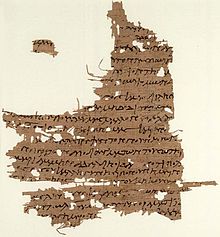Gospel of Mary
The gospel of Mary is one of the apocrypha of the New Testament . It is a Gnostic script that is dated to around 160 AD.
The Mary who named the Gospel may be Mary Magdalene . Since the text itself only speaks of “Maria” in general, this assignment remains uncertain.
The Gospel is the first part of dialogue between the resurrected Jesus and his disciples and disciples. It also contains a vision of Mary in the second part. The two parts seem to have originally been independent of each other. They are connected by the figure of Mary who appears at the end of the first part. In the second part her role is clearly more pronounced, so that the title Gospel of Mary, strictly speaking, only fits the second part of the Apocryphon. According to this, Mary has a special trust in the Savior and knows special revelations that the disciples do not know, and she communicates these as mediator and preacher of the Gnostic revelation and thus takes a position above the apostles.
According to general research, the original of the script was written in Greek. The gospel is only preserved in fragments. The best preserved text of the work is in Codex Berolinensis Gnosticus 8502 , which dates to the 5th century. The text is written in Sahid , a Coptic dialect. Pages 1–6 and 11–14 of the 18-page document have been lost, so less than half of the original text has been preserved. There are also two Greek fragments that were later found in Oxyrhynchos , Egypt . Papyrus Rylands 463 differs in a few points from the Coptic version, while Papyrus Oxyrhynchus L 3525 agrees with the Coptic text.
literature
- Carl Schmidt : A pre-Iranian Gnostic original work in Coptic language . In: Meeting reports of the Royal Prussian Academy of Sciences in Berlin. Born in 1896, 2nd half volume June to December, Berlin 1896, p. 839 f.
- Walter Curt Till (ed.): The Gnostic writings of the Coptic Papyrus Berolinensis 8502, translated and edited . 2nd edition, edited by HU Schenke, 1971, pp. 24–32 and pp. 62–79.
- Wilhelm Schneemelcher (Ed.): New Testament Apocrypha in German translation . Volume I: Gospels. 6th edition, Tübingen 1990, pp. 313-315.
- Christoph Markschies , Jens Schröter u. a. (Ed.): Ancient Christian Apocrypha in German translation. Volume I: Gospels and Related. (two volumes). 7th edition of the collection of the New Testament Apocrypha founded by Edgar Hennecke and continued by Wilhelm Schneemelcher . Mohr Siebeck, Tübingen 2012, ISBN 978-3-16-150087-9 , pp. 1208-1216 (scientific text edition).
- Klaus Berger , Christiane Nord: The New Testament and early Christian writings . Insel, Frankfurt am Main 1999, ISBN 3-458-16970-9 , pp. 1305-1309.
- Uwe-Karsten Plisch: What is not in the Bible. Apocryphal writings of early Christianity . German Bible Society, Stuttgart 2006, ISBN 3-438-06036-1 .
Web links
- Text at gnosis.org (English)
- German translation
Individual evidence
- ^ Walter Curt Till: The Gnostic Writings of the Coptic Papyrus Berolinensis 8502, translated and edited . 1971, p. 26.

